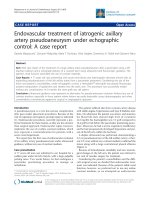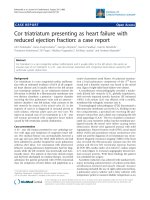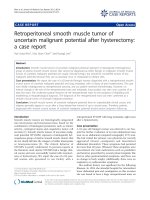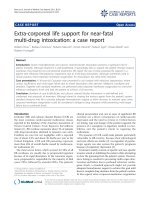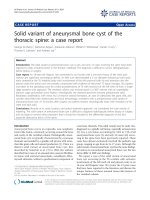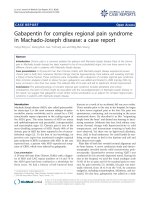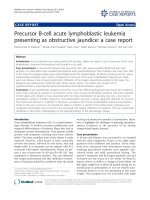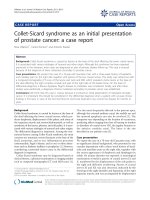Báo cáo y học: "Vertebral osteomyelitis and native valve endocarditis due to Staphylococcus simulans: a case report" pps
Bạn đang xem bản rút gọn của tài liệu. Xem và tải ngay bản đầy đủ của tài liệu tại đây (901.74 KB, 3 trang )
BioMed Central
Page 1 of 3
(page number not for citation purposes)
Journal of Medical Case Reports
Open Access
Case report
Vertebral osteomyelitis and native valve endocarditis due to
Staphylococcus simulans: a case report
Natalia Vallianou*, Angelos Evangelopoulos, Polyxeni Makri,
Georgios Zacharias, Panagiota Stefanitsi, Athanasios Karachalios and
Peter C Avgerinos
Address: Department of Internal Medicine, Polykliniki General Hospital, Athens, Greece
Email: Natalia Vallianou* - ; Angelos Evangelopoulos - ;
Polyxeni Makri - ; Georgios Zacharias - ; Panagiota Stefanitsi - ;
Athanasios Karachalios - ; Peter C Avgerinos -
* Corresponding author
Abstract
Background: Staphylococcus simulans is a common animal pathogen that occasionally can colonize
human skin. Unlike other coagulase-negative staphylococci, S. simulans tends to cause more severe
infections that resemble those caused by S. aureus. We present a case of vertebral osteomyelitis
and endocarditis due to S. simulans. To the best of our knowledge, this is the first report of
vertebral osteomyelitis associated with native valve endocarditis rather than orthopedic surgery.
Case presentation: A 46-year-old male butcher was admitted to the hospital with a 4-week
history of high fever with profound sweating. He reported weakness in his legs and low back pain
that compromised his walking ability. Blood cultures yielded Gram-positive cocci on Gram stain.
These cocci were identified to the species level as S. simulans, a coagulase-negative staphylococcus.
The patient was treated with antibiotics, which were discontinued after 6 months.
Conclusion: This case illustrates the importance of identifying coagulase-negative staphylococci
to the species level. Accurate identification of S. simulans would further help investigations defining
its pathogenic role in human infections.
Introduction
Staphylococcus simulans is a coagulase-negative staphyloco-
ccus, occasionally found on human skin [1]. It is usually
acquired from cattle, sheep and their products [1-3]. We
describe a case of vertebral osteomyelitis and native valve
endocarditis caused by S. simulans. To the best of our
knowledge, this is the first report of vertebral osteomyeli-
tis unrelated to surgery or orthopedic implant infection
caused by this unusual coagulase-negative staphylococ-
cus.
Case presentation
A 46-year-old male butcher was admitted to the hospital
with a 4-week history of high fever with profound sweat-
ing. He reported weakness in his legs and low back pain
that compromised his walking ability. His past medical
history was notable for excessive alcohol consumption,
evidence of portal hypertension (ascites, enlarged spleen)
and depression. On physical examination, he was fully
oriented but had difficulty sitting in the upright position.
There was weakness in his legs, whereas his hands had
Published: 29 May 2008
Journal of Medical Case Reports 2008, 2:183 doi:10.1186/1752-1947-2-183
Received: 15 September 2007
Accepted: 29 May 2008
This article is available from: />© 2008 Vallianou et al; licensee BioMed Central Ltd.
This is an Open Access article distributed under the terms of the Creative Commons Attribution License ( />),
which permits unrestricted use, distribution, and reproduction in any medium, provided the original work is properly cited.
Journal of Medical Case Reports 2008, 2:183 />Page 2 of 3
(page number not for citation purposes)
normal strength. No other neurologic deficit was noted.
His temperature was 39.2°C and poorly localized tender-
ness was found over the lumbar vertebrae.
Routine hematological testing showed anemia (hemo-
globin 8.5 g/dl), mild thrombocytopenia (platelet count
of 132 × 10
3
/mm
3
) and a normal leukocyte count (white
blood cell count 8.38 × 10
3
/mm
3
). C-reactive protein
(CRP) was 10.50 mg/dl and the erythrocyte sedimenta-
tion rate (ESR) was 135 mm/hour. Abnormal liver func-
tion tests (international normalized ratio 1.48 and γ-
glutamyl-transpeptidase 1050 U/liter), anemia and
thrombocytopenia were attributed to excessive alcohol
consumption and alcoholic liver disease.
All three sets of blood cultures yielded Gram-positive
cocci on Gram stain. Initial identification of these cocci
was based on colony and microscopic morphology and a
negative coagulase test. These cocci were subsequently
identified to the species level as S. simulans, a coagulase-
negative staphylococcus, by using the Vitek System
(bioMérieux S.A., Marcy-l'Etoile, France) [1]. Otherwise,
we could have used the ID 32 Staph gallery (bioMérieux)
as both systems are based on a series of biochemical reac-
tions and, therefore, have a very good specificity [2]. Min-
imal inhibitory concentrations (MICs) of the isolate were
determined by the broth microdilution method and the
results were interpreted according to the National Centre
for Surveillance and Intervention (NCSI) recommenda-
tions [3]. The MIC for oxacillin was 4 mg/liter.
Computed tomography (CT) and magnetic resonance
imaging (MRI) scans of the lumbar spine revealed diskitis
of the intervertebral disk at L5-S1 with diffuse edema of
the adjacent vertebrae and paraspinal inflammatory tissue
with incipient abscess formation (Figure 1). A transtho-
racic echocardiogram was negative for vegetations, but a
transesophageal echocardiogram revealed vegetations of
the mitral valve. A CT scan of the brain was performed
owing to the patient's gait instability. This showed two
hypodense lesions: one in the right parieto-occipital
region and one in the right lateral ventricle. These findings
were compatible with recent infarcts and were interpreted
as septic emboli due to endocarditis.
The patient received a 4-week regimen of vancomycin 1 g
intravenously twice a day followed by teicoplanin 400 mg
intravenously daily for a total of 5 months. Vancomycin
was chosen because the isolated strain was resistant to
methicillin. The decision to switch from vancomycin to
teicoplanin was because both drugs have a good penetra-
tion to bone tissue and teicoplanin can be given once
daily, so its use was more convenient. Clindamycin
hydrochloride in a dose of 600 mg, orally, three times a
day, was added to this regimen after the third month of
treatment due to slow progress. The decision to follow
conservative treatment rather than surgery was taken
because the patient remained afebrile and there was
marked improvement of his symptoms. Antibiotics were
discontinued after a 6-month course. At that time, the
CRP level had returned to normal, the ESR had declined
from 135 to 50 mm/hour and there was resolution on the
MRI appearances of osteomyelitis. Two months later, the
ESR was further reduced and returned to normal.
Discussion
S. simulans belongs to the coagulase-negative staphyloco-
cci and is rarely found on human skin [4]. It is a common
animal pathogen and is usually acquired from cattle,
sheep and other domestic animals [4-6]. Anecdotal
reports have associated S. simulans with bacteremia, native
valve endocarditis, post-surgical pubic osteomyelitis,
prosthetic joint infection and urinary tract infection [7-
11]. The scarcity of reported human infections caused by
A magnetic resonance imaging scan of the lumbar spine dem-onstrating abnormal signals of the L5-S1 intervertebral diskFigure 1
A magnetic resonance imaging scan of the lumbar spine dem-
onstrating abnormal signals of the L5-S1 intervertebral disk.
Spinal magnetic resonance imaging revealed diskitis of the L5-
S1 intervertebral disk with diffuse edema of the adjacent ver-
tebrae and a paraspinal inflammatory mass with incipient
abscess formation.
Publish with BioMed Central and every
scientist can read your work free of charge
"BioMed Central will be the most significant development for
disseminating the results of biomedical research in our lifetime."
Sir Paul Nurse, Cancer Research UK
Your research papers will be:
available free of charge to the entire biomedical community
peer reviewed and published immediately upon acceptance
cited in PubMed and archived on PubMed Central
yours — you keep the copyright
Submit your manuscript here:
/>BioMedcentral
Journal of Medical Case Reports 2008, 2:183 />Page 3 of 3
(page number not for citation purposes)
S. simulans is probably due to the infrequent colonization
of human skin by this microorganism as well as the failure
of many microbiology laboratories to routinely identify
coagulase-negative staphylococci to the species level.
Unlike other coagulase-negative staphylococci, S. simulans
together with S. lugdunensis are more virulent and tend to
cause infections that resemble those caused by S. aureus
[12,13]. Indeed, our patient presented with high fever and
native valve endocarditis. There was no history of mitral
valve predisposition to endocarditis (for example, mitral
valve prolapse). This case is supportive of the observation
that infections due to S. simulans are reminiscent of those
caused by S. aureus rather than those caused by most coag-
ulase-negative staphylococci.
The portal of entry of S. simulans in this patient remains
speculative. Given his profession (butcher), colonization
by S. simulans may have taken place while working with
cattle or sheep. Suppressed immunity, owing to impaired
liver function, may have contributed to the severity of his
infection. Therefore, our patient's profession and history
of alcohol consumption provide some clues to the means
of acquisition and spread of S. simulans. To the best of our
knowledge, this is the first report of vertebral osteomyeli-
tis associated with native valve endocarditis rather than
orthopedic surgery.
Conclusion
This case illustrates the importance of identifying coagu-
lase-negative staphylococci to the species level. Accurate
identification of S. simulans would help further in defin-
ing its pathogenic role in human infections.
Abbreviations
CT: computed tomography; CRP: C-reactive protein; ESR:
erythrocyte sedimentation rate; MIC: minimal inhibitory
concentrations; MRI: magnetic resonance imaging.
Competing interests
The authors declare that they have no competing interests.
Consent
Written informed consent was obtained from the patient
for publication of this case report and any accompanying
images. A copy of the written consent is available for
review by the Editor-in-Chief of this journal.
Authors' contributions
NV, PM, GZ, PS, AK and PCA made substantial contribu-
tions to the conception of the study, and analysis and
interpretation of data, AE was involved in reviewing the
laboratory data, drafting and revising the manuscript. All
authors gave final approval of the version to be published.
Acknowledgements
We are particularly indebted to Dr Evangelos Vogiatzakis and the person-
nel of the microbiology laboratory of Polykliniki General Hospital for iden-
tification of the coagulase-negative staphylococci to the species level.
References
1. Sanchez ML, Flint KK, Jones RN: Occurrence of macrolide-lin-
cosamide-streptogramin resistances among staphylococcal
clinical isolates at a university medical center. Diagn Microbiol
Infect Dis 1993, 16:205-213.
2. Lina G, Quaglia A, Reverdy ME, Leclerq R, Vandenesch F, Etienne J:
Distribution of genes encoding resistance to macrolides, lin-
cosamides, and streptogramins among staphylococci. Antimi-
crob Agents Chemother 1999, 43:1062-1066.
3. National Committee for Clinical Laboratory Standards: Methods for
dilution antimicrobial susceptibility tests for bacteria that
grow aerobically. Approved standard M7-A6. National Com-
mittee for Clinical Laboratory Standards. Wayne, Pa; 2004.
4. Kloos WE, Bannerman TL: Staphylococcus and micrococcus. In
Manual of Clinical Microbiology 7th edition. Edited by: Murray PR, Baron
EJ, Pfaller MA, Tenover FC, Yolken RH. Washington, DC: ASM Press;
1999:264-282.
5. Fthenakis GC, Marples RR, Richardson JF, Jones JE: Some proper-
ties of coagulase-negative staphylococci isolated from cases
of ovine mastitis. Epidemiol Infect 1994, 112:171-176.
6. Jarp J: Classification of coagulase-negative staphylococci iso-
lated from bovine clinical and subclinical mastitis. Vet Micro-
biol 1991, 27:151-158.
7. McCarthy JS, Stanley PA, Mayall B: A case of Staphylococcus simu-
lans endocarditis affecting a native heart valve [letter]. J
Infect 1991, 22:211-212.
8. Jansen B, Schumacher-Perdreau F, Peters G, Reinhold G, Schonemann
J: Native valve endocarditis caused by Staphylococcus simu-
lans [letter]. Eur J Clin Microbiol Infect Dis 1992, 11:268-269.
9. Sturgess I, Martin FC, Eykyn S: Pubic osteomyelitis caused by
Staphylococcus simulans. Postgrad Med J 1993, 69:927-929.
10. Males BM, Bartholomew WR, Amsterdam D: Staphylococcus simu-
lans septicemia in a patient with chronic osteomyelitis and
pyarthrosis. J Clin Microbiol 1985,
21:255-257.
11. Nicolle LE, Hoban SA, Harding GK: Characterization of coagu-
lase-negative staphylococci from urinary tract specimens. J
Clin Microbiol 1983, 17:267-271.
12. Barnham M, Horton R, Smith JM, Richardson J, Marples RR, Reith S:
Methicillin-resistant Staphylococcus simulans masquerading
as MRSA in a nursing home [letter]. J Hosp Infect 1996,
34:331-333.
13. Sampathkumar P, Osmon DR, Cockerill FR III: Prosthetic joint
infection due to Staphylococcus lugdunensis. Mayo Clin Proc
2000, 75:511-512.
